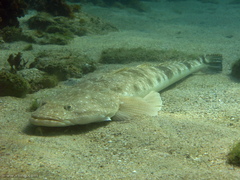It is a large predatory fish and the largest member of the family Platycephalidae.
They can be distinguished from other flathead fine brown spots on the pectoral fins.
Many fishers have been led to believe that large females over 70cm are breeding fish but recent studies are showing that this is not the case and that in fact large females it appears their ovaries have degenerated so are not producing viable eggs, with more studies are being conducted to verify this.
Look at the Tail and the pectoral fins to ID the tail may have a black mark but different to other species.
What habitats does Platycephalus fuscus live in?
They occur over mud, silt gravel, sand and seagrass beds from intertidal areas to depths of 30 m
What is the distribution of Platycephalus fuscus?
East coast of Australia, from Cairns in Queensland to the Gippsland Lakes in Victoria, Not common in most parts of Tasmania, it is reported to occur in small numbers around Flinders Island and the north coast but there have been no confirmed identification
How big does Platycephalus fuscus grow?
Dusky flathead are the largest of the many species of flathead found in Australia, and the most commonly caught. Dusky flathead have very rarely been caught at sizes up to 12–15 kg and lengths up to 1.5 metres, but average size is 0.5–1.5 kg and 40–50 cm
This does not mean that it cannot be found locally, just that I have not been able to verify records at the time this species was added to the database.
Disclaimer: A lot of work goes into trying to identify and ensure accurate identifications are made and that the listed Descriptions, Sizes, Habitats and Distribution information is as accurate and valid as possible. Unfortunately, information in this arena is ever changing and as such no guarantee can be offered that it is correct or currently valid as a result the information is provided as a guide, and it is always suggested that you do a little research to ensure you have the latest and most accurate information. View the reference's or bibliography I welcome any feedback and comments on the information provided.







